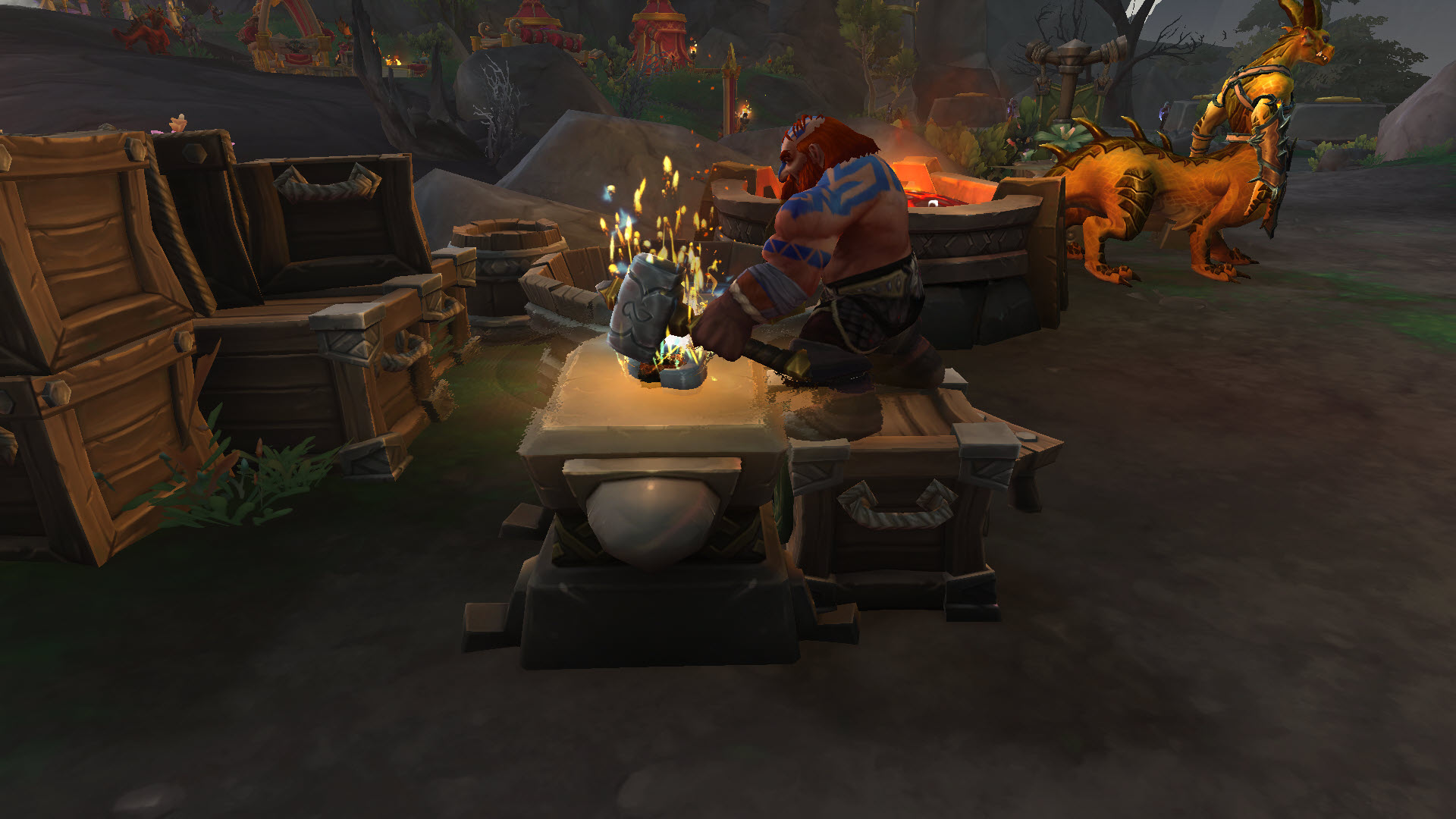WoW Dragonflight professions have changed as the franchise has evolved – ranging from arduous but rewarding, to overly simplistic and unsatisfying. Fortunately, Dragonflight has rebuilt professions to add greater versatility and complexity, creating a layer of depth the game has never seen before.
Players can now equip specific equipment for each WoW Dragonflight profession, consisting of one primary tool and two accessories. In addition to this, WoW Dragonflight talents have returned for more than just character classes and specs. All primary professions have specialisation trees that you can advance by using their professions or obtaining special items.
Primary gathering professions
The gathering professions in WoW Dragonflight consists of mining, herbalism, and skinning, and provide raw materials for crafting professions to make items. The basics of these professions remain unchanged: seek out a mining node, herb, or skinnable creature, and interact with them to gather the materials.
There are three stats associated with gathering professions. Deftness increases gathering speed, finesse increases the number of materials collected, and perception increases the chance of finding rare items. Profession specialisations allow you to upgrade these stats further and unlock special abilities, like gathering materials while mounted. Additionally, materials now have tiers of quality, and gatherers have the skills to refine them to ascend their quality to a higher tier. These skills are easy to level, requiring you to explore and gather materials using your profession.
Mining
The best MMORPG has three types of new ore available to mine: serevite, draconium, and khaz’gorite. Additionally, you can discover modified mining nodes that drop elemental materials, as well as grant buffs or debuffs depending on the node’s modifier. The WoW Dragonflight mining specialisations are mining process, metallurgy, and mastering the elements.
Herbalism
Herbalism is similar to mining in that players find plants they can harvest, and like mining, there are modified herbs that grant additional resources. The new herbs you can gather are hochenblume, bubble poppy, saxifrage, and writhebark. In addition, you can find rare drops of rousing seeds to plant in rich soil and grow into additional herbalism materials. The herbalism specialisations are bountiful harvests, botany, and mastering the elements.
Skinning
Skinning is the most straightforward gathering profession: kill a monster and if it’s skinnable, click on it and collect leather materials. However, skinners can also do some crafting thanks to the bait crafter specialisation. The crafting option gives skinners the ability to construct fishing lures, increasing the collection rates of particular fish. Sub-specialisation crafts include infused bait, which causes lured creatures to drop additional elemental materials when skinned, as well as elusive bait, which summons rare creatures that drop unique materials – or can even be tamed by hunters. The skinning specialisations are bait crafter, tanning, and harvesting.
Primary crafting professions
Primary crafting professions allow you to produce specific types of armour, weapons, accessories, potions, and enhancements. There are four new stats that influence crafting professions in WoW Dragonflight: inspiration, resourcefulness, multicraft, and crafting speed. Inspiration grants a chance to upgrade your crafting skills when making an item. Resourcefulness increases the likelihood of conserving materials. Multicraft improves the odds of crafting multiple items, and crafting speed reduces the time to make an item. Each profession has specialisations that improve these stats, and you earn experience points the first time you craft each item.
Material quality also affects crafted items – for example, weapons and armour made with higher-quality materials have a higher item level, and healing potions restore more health than their lower-quality counterparts. The chances to produce higher quality items increases as you level up your professions, acquire better crafting tools, and spend knowledge points on your specialisations. You can recraft low-quality items into high-quality items by spending additional materials. However, leveling crafting professions can be full of pitfalls, as there’s a chance you may use your materials inefficiently. An accompanying gathering profession is always a good idea, as it can help keep your bags full of materials. There’s also the option to purchase materials at the auction house.
Alchemy
Alchemists can craft healing potions, mana potions, stat-boosting flasks, and specialty potions that boost speed or grant invisibility. Their brewing abilities don’t stop there, they can also create cauldrons that provide potions to raid groups, transmute various materials, and even craft alchemist-only trinkets. Alchemists can specialise in potion mastery, phial mastery, or alchemical theory.
Blacksmithing
Blacksmiths make plate armour, weapons, and consumables items used by melee classes. They can also construct several tools other professions use, forge raw ore into alloys, and create items that unlock dragon riding mount customizations. The blacksmithing specialisations are armorsmithing, weaponsmithing, specialty smithing, and hammer control.
Enchanting
Enchanters can imbue items with additional stat bonuses or special effects, craft wands for casters, and create things that grant cosmetic spell effects to equipment. Players gather materials by disenchanting uncommon, rare, or epic gear. The enchanters specialisations are enchantment, insight of the blue, and rods, runes, and ruses.
Engineering
Engineers produce a wide variety of valuable items, including guns and bombs, tools for other professions, unique pieces of engineer-only gear, and can add ‘tinkers’ to their equipment. This works similarly to enchantments but provides special and exciting effects. The engineer specialisations are optimised efficiency, explosives, function over form, and mechanical mind.
Inscription
Inscriptionists have traditionally crafted glyphs that cosmetically affect player abilities. Unfortunately, there are no new player glyphs in WoW Dragonflight, but they can craft items that unlock customisations for dragon riding mounts. Inscriptionists can craft and upgrade Dark Moon Deck trinkets as they have in past expansions, but more importantly, they can produce items that grant specialization knowledge points to other professions. The inscription specialisations are rune mastery, archiving, and runebinding.
Jewelcrafting
Jewelcrafters produce rings, necklaces, gems, consumable items that add gem slots to equipment, and profession tools. They also make materials used in other professions’ recipes. Jewelcrafters prospect raw ore to create gems they use in most recipes. While jewelcrafting has less new content than other professions, players are always looking for products made by jewelcrafters. The jewelcrafting specialisations are jeweler’s toolset mastery, faceting, setting, and enterprising.
Leatherworking
Leatherworkers produce leather and mail armour pieces in addition to drums, providing a temporary party-wide buff that increases haste by 15%. In addition, leg armour kits have returned, allowing leatherworkers to apply permanent bonuses to leg armor. They can craft tools and accessories for several other professions and have many opportunities to use this profession to earn additional gold. The leatherworking specialisations are leatherworking discipline, leather armor crafting, mail armor crafting, and primordial leatherworking.
Tailoring
Tailors can craft cloth armour, bandages, and bags but now have access to making numerous profession accessories. Additionally, tailors can add spellthread to their leg armor, providing additional armor and stat bonuses. Finally, you can gather cloth by looting humanoid enemies, and produce thread by unraveling fabric instead of purchasing it from vendors. The tailoring specialisations are tailoring mastery, textiles, draconic needlework, and garment crafting.
Secondary professions
Secondary professions are separate from primary professions because any character can learn these in addition to their two chosen primary professions. None of these skills have specialization trees, but cooking and fishing have several noteworthy changes. Like other crafting professions, cooking benefits from inspiration, resourcefulness, multicraft, and crafting speed, whereas fishing only benefits from flat bonuses to fishing skill. In addition, cooking has associated equipment – one tool, and one accessory – while fishing now has an equipment slot for a character’s fishing pole. Archaeology, unfortunately, has yet to receive an update since the Battle for Azeroth expansion.
Cooking remains unchanged in its execution, except that you can use optional reagents to improve resourcefulness and multicraft while cooking temporarily. Catching fish is the same as always: cast your line and click on the bobber when you hear the splash. However, you can now participate in several fishing-related activities, for example, setting nets or completing daily quests to replenish fishing holes to grant buffs to any players close to the area.
Professions throughout the last several WoW expansions have been consistently seen as flat and uninteresting to the player base. However, they now have a far more exciting activity loop in WoW Dragonflight, giving them a much more significant role in end-game content. If you’re interested in getting to Dragonflight’s end-game content quicker, our WoW Dragonflight leveling guide will certainly come in handy. We’ve also got a WoW Dragonflight tier list, as well as a list of the best WoW add-ons for your favourite classes.













